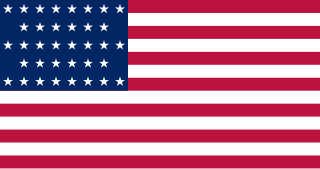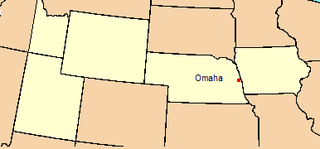Related Research Articles

The territory of the United States and its overseas possessions has evolved over time, from the colonial era to the present day. It includes formally organized territories, proposed and failed states, unrecognized breakaway states, international and interstate purchases, cessions, and land grants, and historical military departments and administrative districts. The last section lists informal regions from American vernacular geography known by popular nicknames and linked by geographical, cultural, or economic similarities, some of which are still in use today.
The Snake War (1864–1868) was an irregular war fought by the United States of America against the "Snake Indians," the settlers' term for Northern Paiute, Bannock and Western Shoshone bands who lived along the Snake River. Fighting took place in the states of Oregon, Nevada, and California, and in Idaho Territory. Total casualties from both sides of the conflict numbered 1,762 dead, wounded, or captured.
The Department of the Pacific or Pacific Department was a major command (Department) of the United States Army from 1853 to 1858. It replaced the Pacific Division, and was itself replaced by the Department of California and the Department of Oregon.

The First Regiment Oregon volunteer Cavalry was a volunteer regiment in United States service Union army that was formed in response to the American Civil War. With men recruited in Oregon and some recruited in surrounding states, the regiment primarily served to protect the state of Oregon and surrounding territories during the American Civil War.
The Pacific coast theater of the American Civil War consists of major military operations in the United States on the Pacific Ocean and in the states and Territories west of the Continental Divide. The theater was encompassed by the Department of the Pacific that included the states of California, Oregon, and Nevada, the territories of Washington, Utah, and later Idaho.

The 4th California Infantry was a volunteer infantry regiment recruited from northern California during the American Civil War. It was organized at Sacramento, Placerville, and Auburn in September and October 1861.

The Department of the Platte was a military administrative district established by the U.S. Army on March 5, 1866, with boundaries encompassing Iowa, Nebraska, Dakota Territory, Utah Territory and a small portion of Idaho. With headquarters in Omaha, the district commander oversaw the army's role initially along the Overland route to Salt Lake City, then later the construction route of the Union Pacific Railroad. The district also included the Montana road through eastern Wyoming. The district was discontinued when the Army's command was reorganized in 1898.

The history of Idaho in the American Civil War is atypical, as the territory was far from the battlefields.

The 1st Oregon Infantry Regiment was an American Civil War era military regiment recruited in Oregon for the Union Army. The regiment was formed in November 1864. At full strength, it was composed of ten companies of foot soldiers. The regiment was used to guard trade routes and escorted immigrant wagon trains from Fort Boise to the Willamette Valley. Its troops were used to pursue and suppress Native American raiders in eastern Oregon and the Idaho Territory. Several detachments accompanied survey parties and built roads in central and southern Oregon. The regiment's last company was mustered out of service in July 1867.
A subdivision of the Division of the Missouri, the Department of Dakota was established by the United States Army on August 11, 1866, to encompass all military activities and forts within Minnesota, Dakota Territory and Montana Territory. The Department of Dakota was initially headquartered at Fort Snelling, Minnesota, and then moved to Saint Paul in March 1867. The 18th Infantry Regiment would serve in Dakota several times. From 1869-1877 the 20th Infantry Regiment was posted to the Department. In 1879 the Department returned to the Fort until 1886 at which time it moved back to downtown Saint Paul. The department was discontinued in 1911.

The 1st Regiment of Washington Territory Volunteer Infantry was a unit of infantry raised by the Washington Territory for service in the Union Army during the American Civil War.

The District of Oregon was a Union Army command department formed during the American Civil War.

The 2nd Regiment California Volunteer Infantry was an infantry regiment in the Union Army during the American Civil War. It spent its entire term of service in the western United States. Organized at San Francisco and Carson City September 2, 1861, to December 30, 1862, and attached to Department of the Pacific. The regiment was first assembled at the Presidio, San Francisco, and after completing its organization, five companies were sent to Oregon and Washington Territory, to relieve the regular troops, and two companies were sent to Santa Barbara. The troops of this regiment sent to Oregon were afterwards returned to California. It was mustered out during the month of October, 1864.
During the American Civil War in the early 1860s, the District of Utah was a subordinate district of the U.S. Army's Department of the Pacific. The district was composed of territorial areas that later became parts of the modern U.S. states of Idaho, Nevada, and Utah.

Camp Henderson was a military outpost in the District of Oregon in 1864, built on Crooked Creek about five miles from where it joins the Owyhee River, 330 miles from Walla Walla. The camp was located at the foot of cliffs on the east side of the valley south of an historical marker located along the highway about six miles east of Burns Junction, Oregon.
The District of California was a Union Army command department formed during the American Civil War. The district was part of the Department of the Pacific, the commander of the department also being District commander. The district was created as a separate command on July 1, 1864, after Irvin McDowell took command of the Department of the Pacific, relieving General Wright, who then remained as District of California commander. The District comprised the state of California and the areas of the Rogue River and Umpqua River in Southern Oregon. Its headquarters were in San Francisco, co-located with those of the Department of the Pacific. On March 14, 1865, the District of Oregon was extended to include the entire state of Oregon, removing the Rogue River and Umpqua River areas from the District.

The Department of Oregon was one of two Army Departments created September 13, 1858, replacing the original Department of the Pacific and was composed of the Territories of Washington and Oregon, except the Rogue River and Umpqua Districts, which were assigned to the Department of California. Its creation was authorized by General Orders, No. 10, of the United States Department of War, Adjutant-General's Office, September 13, 1858. Its headquarters was at Fort Vancouver, in the Washington Territory.

The role of Washington Territory in the American Civil War is atypical, as the territory was the most remote from the main battlefields of the conflict. The territory raised a small number of volunteers for the Union Army, who did not fight against the Confederate States Army but instead maintained defensive positions against possible foreign naval or land attacks. Although the Indian Wars in Washington were recent, there were no Indian hostilities within the area of modern Washington, unlike the rest of the western states and territories, during the Civil War. At the start of the American Civil War, modern-day Washington was part of the Washington Territory. On March 3, 1863, the Idaho Territory was formed from that territory, consisting of the entirety of modern-day Idaho, Montana, and all but southwest Wyoming, leaving the modern-day Washington as Washington Territory.

At the outbreak of the American Civil War, Oregon also raised the 1st Oregon Cavalry that was activated in 1862 and served until June 1865. During the Civil War, emigrants to the newfound gold fields in Idaho and Oregon continued to clash with the Paiute, Shoshone and Bannock tribes of Oregon, Idaho and Nevada until relations degenerated into the bloody 1864 - 1868 Snake War. The 1st Oregon Volunteer Infantry Regiment was formed in 1864 and its last company was mustered out of service in July 1867. Both units were used to guard travel routes and Indian reservations, escort emigrant wagon trains, and protect settlers from Indian raiders. Several infantry detachments also accompanied survey parties and built roads in central and southern Oregon.

Fort Colville was a U.S. Army post in the Washington Territory located three miles (5 km) north of current Colville, Washington. During its existence from 1859 to 1882, it was called "Harney's Depot" and "Colville Depot" during the first two years, and finally "Fort Colville". Brigadier General William S. Harney, commander of the Department of Oregon, opened up the district north of the Snake River to settlers in 1858 and ordered Brevet Major Pinkney Lugenbeel, 9th Infantry Regiment to establish a military post to restrain the Indians lately hostile to the U. S. Army's Northwest Division and to protect miners who flooded into the area after first reports of gold in the area appeared in Western Washington newspapers in July 1855.
References
- ↑ A two-story blockhouse built to protect the Siletz Indian Agency. It was a subpost of Fort Hoskins. Originally called Yaquina Bay Blockhouse (1856–1858) located at the mouth of the Yaquina River near South Beach. It was dismantled and floated upriver in 1858. Located at Siletz, Oregon.
- ↑ Post at Cape Disappointment 1862–63, was at the north mouth of the Columbia River, Washington Territory, later renamed Fort Cape Disappointment 1864 and Fort Canby in 1875.
- ↑ Carey, History of Oregon, pg. 672. Located on the south shore of the mouth of the Columbia River. Later named Fort Stevens.
- ↑ Carey, History of Oregon, pg. 671. On Horse Creek in the Alvord Valley, east of the Steen Mountain Range
- ↑ Carey, History of Oregon, pg. 671. This camp, named for Oregon's representative in Congress at that time, was established early in 1864, near the mouth of Jordan Creek, 330 miles from Walla Walla, and was the center of operations in Southeastern Oregon for some time afterward.
- ↑ Carey, History of Oregon, pg. 671. At the Willow Creek crossing of the Canyon City – Boise Road, south of Baker City.
- ↑ Carey, History of Oregon, pg. 671. On Silver Creek.
- ↑ Carey, History of Oregon, pg. 671. On the Snake River, at the site of Old Fort Hall in S. Idaho Territory.
- ↑ Carey, History of Oregon, pg. 671 East of Canyon City, on the road to Colfax.
- ↑ Carey, History of Oregon, pg. 671 In the Jordan Valley, east of the Owyhee River.
- ↑ IDAHO STATE HISTORICAL SOCIETY REFERENCE SERIES, CAMP LYON, Number 357 July 16, 1965
- ↑ Carey, History of Oregon, pg. 671. On the Deschutes River near the mouth of Crooked River.
- ↑ Carey, History of Oregon, pg. 671,674. On the Snake River, near Salmon Falls, in S. Idaho Territory.
- ↑ Carey, History of Oregon, pg. 674. Located on the on Silvies River, north of Malheur Lake.
- ↑ Carey, History of Oregon, pg. 671. North of Harney Lake. A temporary state militia encampment on the Silvies River, possibly to the south of Burns, Oregon. . Originally Adobe Camp (1865), a 25-yard square sod-walled post, was located here before being replaced after only two weeks.
- ↑ Carey, History of Oregon, pg. 671. Located east of Warner Lakes. A Federal camp originally located 20 miles east of Warner (Hart) Lake. It was moved in 1867
- ↑ Carey, History of Oregon, pg. 671. Located west of Warner Lakes.